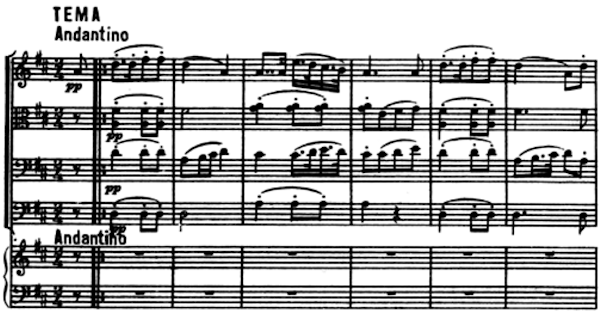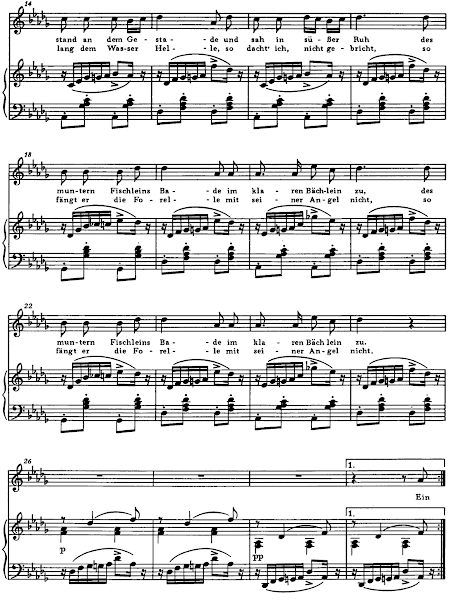Norwegian Chamber Orchestra players (Per Kristian Skalstad, violin; Hanne Skjelbred, viola; Ole Eirik Ree, cello; Kenneth Ryland, double bass; Ole Christian Haagenrud, piano) deliver the second of our themes -- from an NCO chamber series called "Feel Good" ("a weekly dose of music that will lift and comfort your spirits"). [Watch on YouTube.]
(1) A familiar-to-us "Introduction" and "Theme" for flute and piano
(As we've heard, this stand-alone work gets a gorgeous "Introduction")
[Theme at 3;15] Alexander Korneyev, flute; Emil Gilels, piano. Melodiya, recorded in Moscow, 1958
[Theme at 3:01] Jean-Pierre Rampal, flute; Robert Veyron-Lacroix, piano. EMI, published 1959
[Theme at 2:46] Emmanuel Pahud, flute; Eric Le Sage, piano. Valois, recorded in the Salle de Châtonneyre (Switzerland), February 1994
(2) A theme for piano (+violin-viola-cello-double bass) quintet
(I've cheated and tacked on a "Variation" -- so we get to hear the piano!)
Alexander Schneider, violin; Michael Tree, viola; David Soyer, cello; Julius Levine, double bass; Peter Serkin (age 18), piano. Vanguard, recorded in New York City, 1965
Smetana Quartet members (Jiří Novák, violin; Milan Škampa, viola; Antonin Kohout, cello); František Pošta, double bass; Josef Hála, piano. Supraphon-Denon, recorded in the House of Artists, Prague, Oct. 11-14, 1983
Berlin Philharmonic soloists (Guy Braunstein, violin; Amihai Grosz, viola; Olaf Maninger, cello; Janne Saksala, double bass); Yuja Wang, piano. Live performance, Salle Pleyel, Paris, Mar. 20, 2011 [from the Yuja Wang Archives]
Finally, (3) A haunting theme for string quartet --
Tokyo String Quartet (Peter Oundjian and Kikue Ikoda, violins; Kazuhide Isomura, viola; Sadao Harada, cello). RCA, recorded in Richardson Hall, Princeton University, Princeton, NJ, Sept. 19-22, 1989
Brandis Quartet (Thomas Brandis and Peter Brem, violins; Wilfried Strehle, viola; Wolfgang Boettcher, cello). Nimbus, recorded in the Concert Hall of the Nimbus Foundation, Wyastone Leys, Monmouth, Wales, Mar. 2-3, 1994
Kodály Quartet (Attila Falvay and Tamás Szabo, violins; Gábor Fias, viola; János Devich, cello). Naxos, recorded in the Unitarian Church, Budapest, Oct. 8-11, 1991
The Tokyo and Brandis are our speed merchants here, but these are such solid and sonorous players that the music doesn't sound rushed, or at least not too rushed. But enter the wider-open, vibrant-toned, and yet lurkingly dangerous world of the Kodály, and now we've really got something! (Longtime readers know how easily seduced I am by the singing tones of a good Hungarian or Czech string ensemble.) We even get the sense of foreboding built into the music. I like this performance a lot. -- Ed.by Ken
Anyone who happens to have kept tabs on these theoretically weekly posts knows that we're simultaneously immersed in an almost uncountable number of musical inquiries. Today I propose to begin cleaning up an unforgivable breach of Sunday Classics conduct. It dates back [link tk] to when I was taking note of the very musical transformations we're listening to "up-closer." But back then, I merely mentioned that we'd heard them all before and left it at that -- without providing so much as a link!
This isn't how we normally do business in this department. Wherever possible, I try to take advantage of our basic format opportunity: to actually hear stuff that comes up for discussion, or even just mention, not just yammering.
WHAT WE HEARD ARE ALREADY TRANSFORMATIONS --
NOW LET'S GO BACK TO THEIR "SOURCE" FORMS
The nature of those "sources" -- three songs -- is obviously how these themes have come to form a group. And as we hear them, we're also going to hear the final transformations that were wrought on them. I'm going to try to keep the chatter to a minimum, so it'll be (I hope) mostly listening and hearing.
(1) We've spent a deal of time on this song, like here --
SCHUBERT: Die schöne Müllerin (The Beautiful Milleress), D. 795: No. 18, "Trockne Blumen" ("Withered Flowers")
András Schiff & DF-D perform "Trockne Blumen" in Feldkirch (Austria), 1991.
Fritz Wunderlich, tenor; Hubert Giesen, piano. DG, recorded in the Akademie der Wissenschaften, Munich, July 1966
Dietrich Fischer-Dieskau, baritone; Gerald Moore, piano. DG, recorded in UFA-Ton-Studio, Berlin, December 1971
Sanford Sylvan, baritone; David Breitman, fortepiano. Elektra Nonesuch, recorded in Weston Chapel, Weston, Mass., November 1991
Ernst Häfliger, tenor; Jacqueline Bonneau, piano. DG, recorded in the Herkulessaal of the Residenz, Munich, August 1959
You may recall that we've already heard the transformation Schubert performed on "Trockne Blumen." This whole series of inquiries was triggered in part by the late Michael Steinberg's observation, in his booklet notes for Sanford Sylvan and David Breitman's Nonesuch recording of Die schöne Müllerin: "With a callousness for which we would not easily forgive another composer, Schubert two months later composed a brilliant and frivolous set of variations for flute and piano on 'Trockne Blumen'."
Which raises the interesting question, applicable to all three of these song-transformations, of how much, er, "respect" the variationized form is owed to the original -- by the composer, by performers, and by audiences. For starters, as we listen, how much awareness of the originals do our performers seem to show?
SCHUBERT: Introduction, Theme and Variations on "Trockne Blumen" for flute and piano, D. 802
Alexander Korneyev, flute; Emil Gilels, piano. Melodiya, recorded in Moscow, 1958
Jean-Pierre Rampal, flute; Robert Veyron-Lacroix, piano. EMI, published 1959
Emmanuel Pahud, flute; Eric Le Sage, piano. Valois, recorded in the Salle de Châtonneyre (Switzerland), February 1994
(2) One of S.'s most performed, seemingly least troubled songs --
SCHUBERT: "Die Forelle" ("The Trout"), D. 550
Fritz Wunderlich, tenor; Hubert Giesen, piano. DG, recorded in the Hochschule für Musik, Munich, November 1965
Renée Fleming, soprano; Christoph Eschenbach, piano. Decca, recorded in Ozawa Hall, Tanglewood, June 2-6, 1996
Bryn Terfel, baritone; Malcolm Martineau, piano. DG, recorded in the Friedrich-Ebert-Halle, Hamburg, Feb. 25, 1994
As regular readers know, most anything Fritz Wunderlich sings is A-OK by me! This is kind of my idea of "the sound of 'Die Forelle'," not least for Prof. Hubert Giesen's vivid voicing of the rippling-brook-and-trout figure. That said, Renée Fleming too has a lovely time with our swimming trout, and I love Christoph Eschenbach's sharp "etching" of Schubert's beguiling sextuplet rippling figure, with a starker tone quality ready for the harsher realities of the fisherman's "catch" in the third stanza.
It's also fun to have Bryn Terfel's deeper-voiced perspective, and the earned gruffness he applies to the fisherman's intrusion. And Bryn and Malcolm Martineau pull off their lickety-split pace for both the brook and the precious trout swimming in it.
SCHUBERT: Piano Quintet in A, D. 667 (The Trout):
iv. Theme and Variations: Andantino
Mieczyslaw Horszowski, piano; Budapest Quartet members (Joseph Roisman, violin; Boris Kroyt, viola; Mischa Schneider, cello); Julius Levine, double bass. Columbia-CBS-Sony, recorded in Columbia 30th Street Studio, July 8-11, 1962
Emil Gilels, piano; Amadeus Quartet members (Norbert Brainin, violin; Peter Schidlof, viola; Martin Lovett, cello); Rainer Zepperitz, double bass. DG, recorded in the Konserthaus, Turku (Finland), Aug. 31 & Sept. 4, 1975
Georges Pludermacher, piano; Trio à cordes français (Gérard Jarry, violin; Serge Collot, viola; Michel Tournus, cello); Jacques Cazauran, double bass. EMI, recorded in the Salle Wagram, Paris, Apr. 17-19, 1974
Finally (3), this tiny song, a powerhouse of the art-song lit --
SCHUBERT: "Der Tod und das Mädchen" ("Death and the Maiden"), D. 531
One obvious thing to note about this unique song, beyond its relative tininess (note how it can be fit on a single printed page!), is the profusion of same-note repetitions, notably that D-natural sounded so granticallyg "ritornello" (when we get to spending more time with the song, Graham Johnson wil be referring to this figure as a ritornello, or recurring ["returning"] phrase) and in Death's annunciation to the Maiden.
Of course the piano is constantly changing the harmonies around that D-natural. Still, you'd think the note-repetition would wear thin for the listener. Now it's possible that Schubert just couldn't think of any other notes. But "lack of notes" doesn't ever seem to have been a problem for him. And the fact is that those seemingly endless note repetitions have the opposite effect: of riveting the listener.
For today we've got an all-Gerald Moore lineup. You can even watch him!
Victoria de los Angeles, soprano; Gerald Moore, piano. EMI, recorded in EMI Barcelona Studios, Sept. 8-11, 1960
Christa Ludwig, mezzo-soprano; Gerald Moore, piano. BBC-TV, 1961 (with apologies for the non-optimal TV sound -- watch on YouTube)
Dietrich Fischer-Dieskau, baritone; Gerald Moore, piano. DG, recorded in UFA-Ton-Studio, Berlin, Feb.-Mar. 1969
In a sense, there's hardly anything more that needs to be said about "Der Tod und das Mädchen." But in other senses, there's hardly any end of things that deserve to be said. And the same is true of the form into which Schubert recast this prized song.
SCHUBERT: String Quartet No. 14 in D minor, D. 810 (Death and the Maiden): ii. Andante con moto
Brandis Quartet (Thomas Brandis and Peter Brem, violins; Wilfried Strehle, viola; Wolfgang Boettcher, cello). Nimbus, recorded in the Concert Hall of the Nimbus Foundation, Mar. 2-3, 1994
Chilingirian Quartet (Levon Chilingirian and Mark Butler, violins; Simon Rowland-Jones, viola; Philip de Groote, cello). Nimbus, recorded in Wyastone Leys, Hertfordshire, England, July 18-21, 1978
Alban Berg Quartet (Günter Pichler and Gerhard Schulz, violins; Thomas Kakuska, viola; Valentin Erben, cello). EMI, recorded in the Evangelische Kirche, Seon (Switzerland), Dec. 14-21, 1984
Juilliard String Quartet (Robert Mann and Isidore Cohen, violins; Raphael Hillyer, viola; Claus Adam, cello). RCA, recorded at the American Academy of Arts and Letters, New York City, Feb. 5-6, 1959
Juilliard String Quartet (Robert Mann and Earl Carlyss, violins; Samuel Rhodes, viola; Joel Krosnick, cello. Columbia-CBS-Sony, recorded in Columbia 30th Street Studio, New York City, 1979
THOUGHTS TO THINK ABOUT BETWEEN NOW AND
WHEN WE COME BACK TO THESE THREE SONGS-PLUS"
Because yes, we are going to come back to them, and break down the theme-and-variations versions into their component variations -- something I feel I've rarely done enough of in listening even to exceedingly familiar examples. I kind of just let them go by. This is going to involve some looking back at the extraordinary 1991 TV series Orchestra!, in which Sir Georg Solti and Dudley Moore play -- and play with -- two of the variations in the two-piano version of one of the great sets, Brahms's Not-by-Haydn Variations, which Sir Georg also worked on with the Schleswig-Holstein Felstival Orchestra of 20-somethings. I must have owned the DVDs for upwards of three decades before finally looking seriously at them. They're killer. They're also spectacular memorials to Sir Georg and Dudley M., two remarkable artists who seemed to "breathe" music as a means of communication.
(1) For both performers and listeners, how closely connected are the original song form and the variations sets? Schubert himself made some interesting differentiations, for example the Andantino tempo marking tempo marking he assigned to the string-quartet movement based on "Die Forelle," noticeably slower that most of the markings for the five (yes, five) published versions of the song.
(2) How confident are we that we know the intended tone of the songs -- and, for that matter, of the theme-and-variations sets? For example, in "Death and the Maiden," Death sounds like such a nice, helpful fellow, almost like a friend. Is Death our friend? In my experience, the song has usually provoked in me something close to raw terror. When we return to the song, we're going to hear from both our master Schubert-song pianists, Gerald Moore and Graham Johnson, who seem to be taking different views. But do their hands necessarily take those same views?
TO BE CONTINUED


















No comments:
Post a Comment